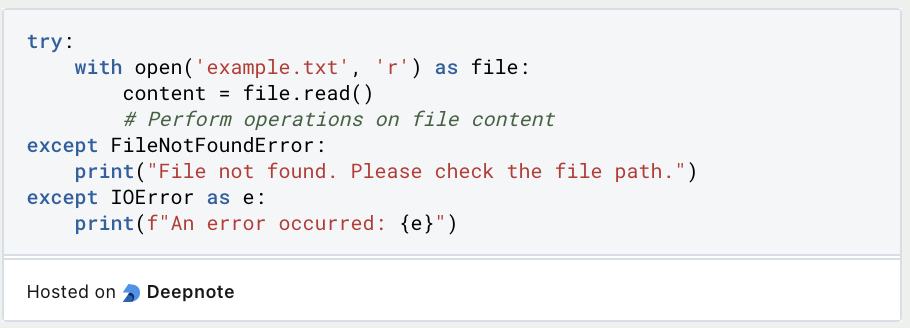Python, a versatile and powerful programming language, offers robust functionality for handling files. Whether you’re reading data from external sources, writing logs, or managing configurations, mastering Python file handling is a fundamental skill for every Python developer. In this comprehensive guide, we’ll delve into the intricacies of Python file handling, covering everything from basic operations like reading and writing to more advanced topics like exception handling and working with various file formats. Join us on this journey to harness the full potential of Python’s file handling capabilities and enhance your programming repertoire.
What is Python File Handling?
Python file handling refers to the process of manipulating files—reading from them, writing to them, or performing other operations. It involves using built-in functions and methods to interact with files, enabling developers to seamlessly incorporate external data, store information, or manage configurations within their programs. Python’s file handling capabilities offer a versatile and essential toolkit for handling diverse file-related tasks, making it a pivotal aspect of Python programming. Whether you’re working with text files, binary files, or exploring more complex operations, Python provides a user-friendly yet powerful set of tools for effective file management.
How can you open and close files in Python?
In Python, the open() function is the gateway to file operations, offering flexibility with various modes tailored to different tasks. Understanding its parameters and the importance of closing files is crucial for efficient Python file handling.
- The
open()Function: Theopen()function takes two main parameters — the file path and the mode. Modes include:'r': Read mode (default).'w': Write mode (creates a new file or truncates an existing one).'a': Append mode (writes to the end of the file).'b': Binary mode (for handling binary data).'x': Exclusive creation, if the file does not exist.
Additionally, combinations like'rb'or'w+'are possible, providing read and write capabilities.

- Closing Files Using
close():
While opening a file is crucial, equally important is closing it after operations are complete. Theclose()method ensures that resources are released, preventing potential issues and maintaining system efficiency.

- Using the
withStatement:
A cleaner approach is to use thewithstatement. It automatically manages resources, eliminating the need for explicitclose()calls. This is especially useful for avoiding oversight or errors related to unclosed files.

Understanding the intricacies of the open() function and the importance of proper closure sets the foundation for effective Python file handling.
How can you read data from files?
Python offers various methods to retrieve data from files, each serving distinct purposes. Understanding these methods empowers developers to efficiently extract information from diverse file types.
- Using
read():
Theread()method reads the entire content of a file as a single string. For instance:

- Using
readline():readline()reads a single line from the file. Subsequent calls read subsequent lines. This is beneficial for processing files line by line.

- Using
readlines():readlines()returns a list containing each line as an element. This is useful when you want to manipulate the lines as separate entities.

- Reading Binary Files:
Reading binary files involves using modes like'rb'. Theread()method works similarly for binary files.

Ensure proper understanding of the file content to handle binary data effectively.
Adopting these methods enables developers to navigate and process file content seamlessly, whether dealing with plain text or binary data.
How can you write the files?
Manipulating files involves not only reading data but also writing information back. Python provides versatile methods for this purpose, accommodating both text and binary data.
- Using
write():
Thewrite()method is employed for adding content to a file. When opening a file in write mode ('w'), it truncates existing content or creates a new file if none exists.

- Using
writelines():writelines()is suitable for writing multiple lines to a file. It takes an iterable (e.g., a list of strings) and adds each element as a line.

- Writing Binary Data:
For binary data, use modes like'wb'. Thewrite()method works similarly for binary files.

Ensure appropriate encoding and decoding mechanisms for handling binary data effectively.
By mastering these methods, developers can seamlessly integrate file writing into their Python applications, creating, updating, or modifying content as needed.
How can you append data to files?
Appending data to existing files is a common requirement, especially when you want to add new content without overwriting the file’s current content. Python simplifies this task with the append mode ('a').
- Using Append Mode:
The append mode ('a') ensures that new content is added at the end of the file without affecting existing data.

The write() method in append mode seamlessly integrates new information into the file.
- Appending Multiple Lines:
To append multiple lines, you can use a loop orwritelines()with an iterable containing the lines to be added.

This approach is particularly useful when dealing with batches of data.
Appending to files is valuable for scenarios where continuous data needs to be added without erasing what’s already present. Understanding the append mode provides developers with a versatile tool for file management in Python.
How can you work with file objects?
File objects in Python offer attributes and methods that facilitate efficient navigation and manipulation of file content. Understanding these features enhances the versatility of Python file handling.
tell()Method:
Thetell()method returns the current position of the file cursor, indicating the byte offset from the beginning of the file.

seek()Method:
Theseek(offset, whence)method moves the file cursor to a specified position. Theoffsetparameter denotes the number of bytes to move, andwhencedefines the reference point for the offset.

- File Object Attributes:
File objects also have attributes likemode,name, andclosed. These provide information about the file, such as its access mode, name, and whether it’s closed.

These file object attributes and methods empower developers to navigate within files, modify cursor positions, and retrieve crucial information about the file itself. Efficient utilization of these tools ensures precise control over file interactions in Python.
How can you do Exception Handling in Python File Operations?
Error handling is crucial in file operations to anticipate and manage potential issues that may arise during reading, writing, or manipulating files. Python provides the try-except block to gracefully handle exceptions.
- Using try-except Blocks:
Enclose file operations within atryblock, and use an accompanyingexceptblock to catch and manage exceptions.

- Handling Specific Exceptions:
Tailor exception handling based on specific error types. In the example above,FileNotFoundErroraddresses cases where the specified file is not found, whileIOErrorcatches general input/output errors. - Ensuring File Closure:
Use thefinallyblock to guarantee that the file is closed, even if an exception occurs.

Proper exception handling ensures that your code remains robust and resilient in the face of unexpected issues, promoting more reliable file operations in Python.
What are the advantages of using the with-parameter?
The with statement is a powerful tool for Python file handling, especially when working with I/O operations. It ensures proper resource management, such as file closure, and offers several advantages.
- Automatic Resource Management:
The primary benefit of thewithstatement is its ability to automatically manage resources, ensuring that files are properly opened and closed. This prevents potential issues like resource leaks.

- Exception Handling:
Thewithstatement simplifies exception handling by automatically handling exceptions related to file operations. If an exception occurs within thewithblock, it is caught, and the file is closed without the need for explicit code.

- Cleaner and Concise Code:
Usingwithleads to cleaner and more concise code. It eliminates the need for explicit calls tofile.close()and reduces the risk of forgetting to close the file.

The with statement is a best practice for Python file handling, offering not only cleaner and more readable code but also ensuring proper resource management and reducing the likelihood of errors related to file operations.
How can you handle different file formats and file modes?
Python supports various file modes and formats, allowing developers to interact with different types of data. Understanding file modes and formats is essential for effective file handling.
File Modes:
- Text Mode (
't'): Default mode for working with text files. It reads and writes data as strings. Example:

- Binary Mode (
'b'): Used for working with binary files, reading and writing raw binary data. Example:

File Formats:
- CSV (Comma-Separated Values):
Reading CSV:

Writing CSV:

JSON (JavaScript Object Notation):
Reading JSON:

Writing JSON:

Understanding and leveraging different file modes and formats enable developers to handle a wide range of data types in Python, making it a versatile language for file manipulation.
What are real-world examples of Python File Handling?
In practical programming scenarios, Python file handling capabilities find meaningful applications. One such use case involves the manipulation of configuration files. These files store essential parameters for applications, and Python’s ability to read and write them facilitates efficient management of settings. This adaptability ensures that applications remain configurable, allowing developers to tailor them to specific needs.
Another crucial application is in logging data, a fundamental practice for debugging and monitoring applications. Python file handling supports the recording of events and errors, providing developers with valuable insights to identify issues promptly. This contributes to improving the overall reliability and stability of systems.
Moreover, Python file handling is instrumental in dealing with large datasets, a common requirement in data science and analytics. The language’s capabilities enable the efficient reading and processing of extensive data sets, offering scalable solutions for handling substantial amounts of information.
These real-world examples underscore the importance of Python file handling capabilities in diverse practical scenarios. Whether configuring applications, logging critical events, or managing large datasets, Python’s file handling plays a crucial role in enhancing the robustness and adaptability of software systems.
What are common pitfalls for Python File Handling?
Navigating Python File Handling comes with certain pitfalls that developers should be aware of to ensure smooth execution. Here are some common pitfalls to watch out for:
1. Neglecting File Closure: Failure to close files after reading or writing can lead to resource leaks. It’s crucial to use proper file closure mechanisms, such as the with statement, to ensure that system resources are freed up appropriately.
2. Incorrect File Paths: Providing incorrect file paths is a frequent error. Ensure that the file paths specified in your code are accurate and accessible. Incorrect paths can result in FileNotFoundError or IOError, disrupting the intended file operations.
3. Unintentional Data Overwriting: Writing to files without proper checks may lead to unintentional data overwriting. Before performing write operations, developers should consider implementing checks to avoid overwriting existing data inadvertently.
4. Lack of Exception Handling: Failing to handle exceptions in file operations can result in runtime errors that disrupt the program’s flow. Implementing robust error-handling mechanisms, such as try-except blocks, helps anticipate and address potential issues.
5. Mixing Text and Binary Modes: When working with files, it’s essential to use the correct mode—text or binary. Mixing these modes can lead to unexpected behavior and errors. Developers should be explicit about the mode they intend to use.
6. Inadequate Validation: Lack of proper input validation for file-related operations can introduce vulnerabilities. It’s crucial to validate user input, especially when dealing with file paths or user-generated data, to prevent security issues.
7. Poor Cursor Management: Incorrect usage of file cursor positioning functions like tell() and seek() can result in data misalignment or corruption. Developers should understand and use these functions appropriately to manage the file cursor.
Being mindful of these common pitfalls and adopting best practices in Python file handling helps developers create robust and error-resistant code, ensuring the reliability and security of file-related operations in Python.
This is what you should take with you
- Python provides robust tools for various file operations, including reading, writing, and appending.
- Exception handling is crucial to anticipate and gracefully manage errors during file operations, enhancing code robustness.
- The ‘with’ statement ensures automatic resource management, guaranteeing proper file closure and simplifying exception handling.
- Python file handling capabilities, combined with the ‘with’ statement, enable developers to write clean, concise, and readable code.
- Striking a balance between data access for business insights and respecting privacy is essential for responsible data collection.
- Keeping abreast of Python file handling advancements and incorporating best practices ensures developers can adapt to evolving requirements.
- Python file handling is a fundamental aspect of programming, and mastering these techniques contributes to efficient and error-resistant code. Adopting best practices and staying informed about Python’s evolving features empowers developers to navigate file operations seamlessly.
What is Jenkins?
Mastering Jenkins: Streamline DevOps with Powerful Automation. Learn CI/CD Concepts & Boost Software Delivery.
What are Conditional Statements in Python?
Learn how to use conditional statements in Python. Understand if-else, nested if, and elif statements for efficient programming.
What is XOR?
Explore XOR: The Exclusive OR operator's role in logic, encryption, math, AI, and technology.
How can you do Python Exception Handling?
Unlocking the Art of Python Exception Handling: Best Practices, Tips, and Key Differences Between Python 2 and Python 3.
What are Python Modules?
Explore Python modules: understand their role, enhance functionality, and streamline coding in diverse applications.
What are Python Comparison Operators?
Master Python comparison operators for precise logic and decision-making in programming.
Other Articles on the Topic of Python File Handling
Here you can find an article on how to handle files in Pandas.

Niklas Lang
I have been working as a machine learning engineer and software developer since 2020 and am passionate about the world of data, algorithms and software development. In addition to my work in the field, I teach at several German universities, including the IU International University of Applied Sciences and the Baden-Württemberg Cooperative State University, in the fields of data science, mathematics and business analytics.
My goal is to present complex topics such as statistics and machine learning in a way that makes them not only understandable, but also exciting and tangible. I combine practical experience from industry with sound theoretical foundations to prepare my students in the best possible way for the challenges of the data world.





